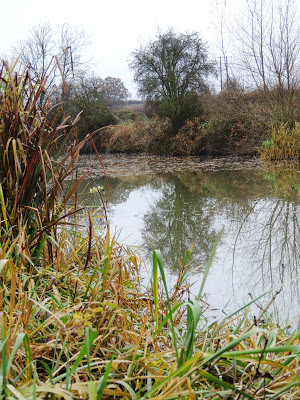Where to start?
Well, the continual rain had to be braved after ducking-out of two consecutive early morning trips to roachland and fortune favoured the decision as the drizzle held off long enough to enable camp to be made
The general area of the venue was one visited earlier in the year when two skimmers were taken while after roach on rod and line http://floatflightflannel.blogspot.co.uk/2012/05/interlude.html. Conditions now seemed more than perfect however. The unseasonal air temperature was 10degC and the water felt less cold than of late (speculation wouldn't be necessary in future as I returned home to find the present of a water thermometer on my pillow!), there was a variable ripple on the water with 20mph winds blowing overhead above a bank, the water clarity was good with visibility to about 6" down, ideal for bread and the combination was suggesting a good roaching day ahead
Furthermore there was the option to fish as long as 'necessary' with only Parps to take Warhammering late in the day
The general location had been known to produce very good roach catches in the distant past but it had changed a little, less overhanging branches and shallower on the far side which formed the outside of a widening bend
Two areas were fed with bread, one halfway up the slow far shelf and one close to the bottom of the steeper near shelf to the left. I had also, for the first time ever, bought, BOUGHT!, some lobworms to fish for chub during the holiday, so, with the rivers more regularly in the fields than within their banks, the opportunity to use some of those before they expired seemed, well, opportune, and they went in to the right on the same close line just on the off-chance and with the hope of snaring one larger than those to date
The wind proved something of a greater challenge than first anticipated and fishing the far line proved somewhat tricky but, after much fiddling with rigs, depths, etc., a bite was forthcoming after trying both bread lines and returning to the far line. The fish came off the hook on the return but didn't feel huge
After an hour the bread lines were rested having been re-fed and an inch and a half tail of lob lowered into the worm-laced area to the right, viewable under the dripping hem of the now soaked brolly. This met with a couple of immediate bobs and pulls before the float slid away and a perch of around 10-12ozs came to the net
 |
| Cracking perfectly formed canal perch at 1lb 8ozs |
The worm line was regularly rested and re-fed while bread was tried again and again however no further bites were attracted with that method and soon the reason was to become apparent
Next put-in on lobworm produced a fish which felt quite different, a more 'kitey' fight than the 'digging' of the previous perch shoal. It took a touch longer to tame and, once tiring on the pole with no.6 elastic, it popped up to reveal itself as a zander. Immediately obvious as another PB having taken my first of a pound and a half only a few weeks ago. This one went 1-15-0
This was followed by another perch and then a smaller zander of 11ozs before a fish was lost of noticeably more significant proportions
By this time the weather had deteriorated quite dramatically as the brolly tried to turn itself inside-out while that great sprinkler system in the sky let loose. Bites had subsided and another dabble with bread was tried but then abandoned for good as, upon returning to the worm line, another zander of 2-11-0, and another PB, fell to a huge chunk of lobworm dragged past its nose
 |
| PB canal (or anywhere) zander at 2lbs 11ozs |
The best catch I could recall from the previous life was around 10lbs of roach from pretty much this very peg but this was to outstrip that quite comfortably as the eight perch (not quite a full team but enough for five-a-side and three subs) totalled 7-0-5...
 |
| So not the tidiest of pictures but the conditions were swamp-like at this stage |
...and the four zander (they would keep control as the officials) dragged the scales down to 6-5-10
 |
| Toothy monsters looking bizarrely dead due to their natural gaping posture but very much alive |
For this to include two zander canal PB's on the pole and a perch within a gnats whisker of the ancient canal best in the same session was quite some Christmas present and more than made up for the lack of roach. It also gave credit to the worm option and in future this is something to keep up the thermal sleeve although it wouldn't want to interfere with the roach quest but may well be deployed on longer sessions and come into play if, at the hour and a half mark, no roach had been tempted
Interestingly, being a newcomer to catching zander, only one of them was properly hooked so the need to keep pressure on them is clearly paramount. These did fight quite well in an aggressive breamy kind of manner...but then they were on the pole!




































